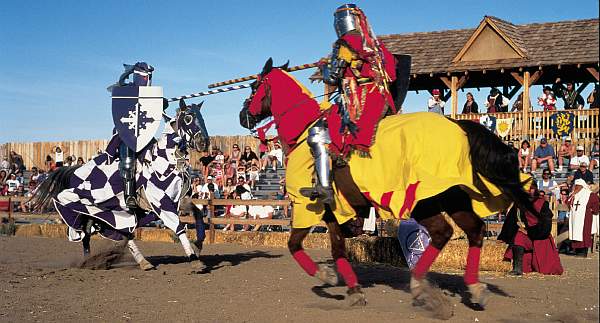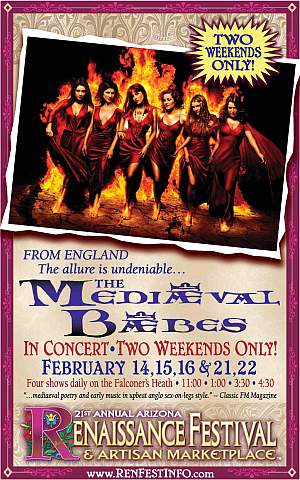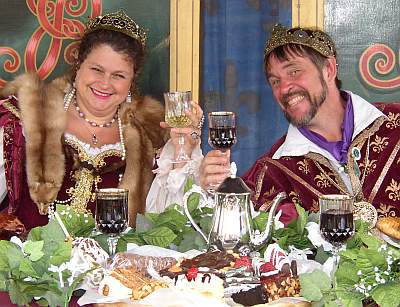The Middle Ages: Sanitized for your Protection

One thing I’ve noticed in my eight years here is the fondness the United States has for taking history and re-inventing it, in order to make it ‘better’ – which can mean anything from ‘more palatable’ to simply ‘more fun’. A simple if unscientific study shows what I mean here: if you Google the term ‘America lost in Vietnam’ you get just over six million hits. If, however, you search for ‘American won in Vietnam,’ that number soars to somewhere above thirty-eight million. Looks like Arizona native John Rambo was right when he asked, “Do we get to win this time?” though perhaps even more disturbingly, “America won World War Three” gets 693 million hits.
The Renaissance Fair, while not uniquely American, is certainly largely so, and seems to me another example of that strange trait. We in Europe have little or no interest in recreating the Middle Ages as a group. We’ve been there, done that, lanced the buboes. But America didn’t exist at that point – okay, I know a few Native Americans would argue with me on that, geographically, but I mean as an independent country. It’s as if the United States feels the need to make up being late to the national party, by going back and rehashing all the centuries on which they missed out. Historical accuracy is more an afterthought at a Renaissance Fair: suspension of disbelief is rendered almost impossible, when the crowd are less likely to be dressed in tights and chain-mail than jeans and chain-mall attire.

What started as a class activity at the home of a Los Angeles schoolteacher, Phyllis Patterson in the early 60’s, has become a good deal more. Patterson’s backyard endeavour is now the Renaissance Pleasure Faire, which has over two thousand costumed performers, seven parades per day, fourteen stages of entertainment and around 150 artisans. Who knew the Middle Ages were so much fun? [It’s also helped spawn quite a few names. Charlie Sheen, Rosanna Arquette and Penn Jillette are among those who have worked at it]
And it’s far from being the only such event. Virtually every state in the country – even Alaska – now has them in a variety of shapes and sizes, from one-day events all the way to monsters like the Texas Renaissance Fair. That takes place over the best part of October and November, and has pulled in more than 370,000 visitors. Right up in the top rank – probably among the five biggest, nationwide – is the Arizona Renaissance Festival, which first took place in 1989 and now occupies a 30-acre site so far out to the south-east, it’s beyond even the suburban sprawl of Phoenix. It’s clear that entertainment comes first and foremost: the official press release describes the festival as “a Monty Python movie come to life.” And they clearly don’t mean the one about Brian, either. It goes on: “enjoy the pleasures of a simpler time in a storybook town… continuous music, dance and comedy shows, shop for wonderful arts and crafts, plus games, rides and a feast of exotic food and drink.” What? No killer rabbit? Not very like a Monty Python movie after all then, is it?
We had free tickets this year, including the Pleasure Feast, a six-course banquet, which was as much a variety show as a culinary experience, but worked pretty well as both. The food was certainly better than the average dinner theatre, I found myself thoroughly entertained – though any show where they keep coming past and filling up your tankard with more beer, is likely to skip fairly easily through the doorway of my critical acclaim. Stuffed to the gills, we rolled out of the banquet hall and began wandering around the fair. Or faire. Or fayre. For antiquated spelling is just about mandatory, with “Ye Olde [insert product] Shoppe” being par for the course.
Inhabiting the grounds are a large number of characters, though it was hard to be sure who were actually employees and who were paying customers, being a bit more extrovert than they should. This is where I begin to find things a little creepy: an interest in the past is fine, but when you feel the need to take on an entire independent character from a different time period… Here, the RenFest begins to occupy much the same ground as the Society for Creative Anachronism which, curiously enough, also started during the 60’s in a Californian backyard [likely not a coincidence: as they say, if you lived in California and remember the sixties, then you weren’t really there], who re-create the Middle Ages “as they ought to have been.” Chris used to be a member, and attended Pennsic War, their central event which draws 10,000+ each yet to Pennsylvania. She, however, opted to stay in hotels, an eminently sensible choice and is no longer a member – our review of the film Darkon gives some more insight into this general field of human activity, if you’re interested.

I have a theory about such groups and those who choose to inhabit an alternative persona: basically, it’s because they’re more or less unhappy with their actual lives. I don’t really want to go into this in depth, since I recall getting into a lot of flak in the anime community when I put forward much the same hypothesis about those who take part in cosplay. Though if I recall, I was somewhat less diplomatic about expressing myself. [The line was somewhat alcohol-fuelled, and went something like “I stopped playing dress-up when I was eight.”] I certainly acknowledge the importance of escapism as a release-valve, but the principle expressed by Roman playwright Terence in the second century B.C. applies: Ne quid nimis or, “Moderation in all things.” But if you’re not a professional actor, then it seems a legitimate question; what exactly are you escaping from, by turning yourself into another person? However, it’s been a long time since I saw so much cleavage in one place, though the quantity was not necessarily matched by the quality, it has to be said.
Thoroughly unqualified psychological analysis aside, and back at the RenFest, we headed over to the jousting, being big fans of theatrical, staged violence. Did they really have cheerleaders in medieval times? They did here, with four knights, each assigned to a section of the crowd, and each with a rabble-rouser – us being the rabble – to ensure that we gave full support to the knight of our choice. Was this historically accurate? Or more something inspired by A Knight’s Tale? Painstaking research – literally, minutes spent on Google – were unclear on this. And what the hell was a pirate doing taking part in the joust? Johnny Depp has a lot to answer for, but since there are a couple in IZW too, we are hardly in any position to be critical.
Sadly, we had to leave before the Fight to the Death, scheduled for 5pm. Still, having got our fix of senseless mayhem, we headed back, passing the giant turkey leg stall [obvious question: what do they do with the rest of the giant turkey?], the belly-dancers and the ax-throwing, as well as less traditional features such as the photo booth or ATM – sorry, Ye Olde ATME – and returning to the modern world in the thoroughly authentic recreation of a 20th-century car-park. While amusing enough, I can’t say I’m too sorry to be back and definitely prefer the land of high-speed Internet, satellite television and microwave popcorn to the Middle Ages. Or even the Middle Ages as they ought to have been…